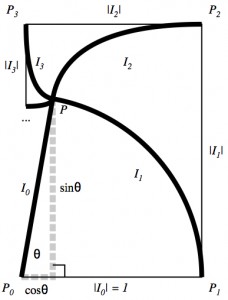When you (like I) think that the trig functions are best understood as segments within the Complete Triangle, you tend to believe that just about every important fact about those functions has a nifty geometric interpretation. (See other posts in this category.)
Why shouldn’t we expect this to be true of the functions’ power series?
(Maybe because taking powers of angles isn’t the most intuitive process?)
As it turns out, mathematician (and teacher) Y. S. Chaikovsky elegantly illustrated the power series for sine and cosine as a kind of pinwheel of involutes (first the involute of the circular arc, then the involute of that involute, then the involute of that involute, and so on).
In the diagram, the thick curves, \(I_i\), are the successive involutes. (We include the radius segment as \(I_0\) and the circular arc as \(I_1\) for symbolic completeness.) The nature of involutes is that they trace the path of “unrolling” a curve, which effectively transfers the lengths of the curves in the involute pinwheel onto the sides of the polygonal spiral. As the corners of that spiral —\(P_0, P_1, P_2, P_3, \dots\)— close in on the tip of the inclined radius segment, alternately over- and under-shooting the mark both horizontally and vertically, we see
\cos\theta &= |I_0| – |I_2| + |I_4| – \cdots = \sum (-1)^i |I_{2i}| \\
\sin\theta &= |I_1| – |I_3| + |I_5| – \cdots = \sum (-1)^i |I_{2i+1}|
\end{align}}\)
A little combinatorics, and an appeal to a basic Calculus result —namely, \(\lim_{x\to 0} \frac{\sin x}{x} = 1\)— help Chaikovsky show that the lengths of successive involutes depict powers of the angle (that is, powers of the length of the circular arc) —\(|I_i| = \frac{1}{i!}\theta^i\)— so that we have our power series
\cos\theta = \sum (-1)^i \frac{\theta^{2i}}{(2i)!} \qquad \sin\theta = \sum (-1)^i \frac{\theta^{2i+1}}{(2i+1)!}}\)
A nifty geometric interpretation, indeed!
With a very-minor conceptual tweak (along with some more-intense combinatorial analysis), I was able to adapt Chaikovsky’s involute pinwheel into an involute zig-zag illustrating the series for secant and tangent (in their natural habitat as segments of the Complete Triangle!):
A full discussion is here: “Zig-Zag Involutes, Up-Down Permutations, and Secant and Tangent”.
The Open Question in this:
What about Cosecant and Cotangent?

